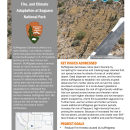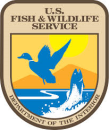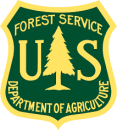Location
States
ArizonaEcosystem
DesertIntroduction
The Sonoran Desert of northwestern Mexico and southern Arizona and is a semi-arid desert with rain split between summer monsoons and the temperate winter months. It is the most biodiverse desert in the world and is home to the saguaro cactus (Carnegiea gigantea), an at-risk species that is only found in the Sonoran Desert. Saguaro National Park (SNP), located near Tucson, Arizona, was established in 1933 to preserve the saguaros and other unique plants. SNP contains a mix of ecosystems including the Sonoran Desert, desert grassland, pine/oak woodland, and mixed conifer forest in higher elevations (Jarnevich, 2022). Invasive perennial grasses in the Sonoran Desert threaten native plant biodiversity by outcompeting native plants, like saguaros, for resources and by heightening risks for high-intensity wildfires, which Sonoran Desert ecosystems are not adapted to. SNP seeks to remove invasive grasses, mainly buffelgrass (Cenchrus ciliaris), from the park to reduce the risk of extremely damaging, high-severity wildfires and restore native species and natural landscapes.
Buffelgrass is an invasive, non-native, warm-season perennial grass native to regions of Africa, Asia, and the Middle East. It was introduced in the 1930s for livestock grazing and to reduce soil erosion. Buffelgrass poses a serious threat to native Sonoran Desert ecosystems by crowding areas with sparse native plant distribution and acting as a flammable fuel source for intense wildfires that native plant and animal species in the Sonoran Desert do not have the adaptations to withstand.
Since 1993, SNP has made efforts to reduce or completely remove buffelgrass from the park. These efforts include hosting volunteer-based buffelgrass pulls in winter months when seed germination is low. In 2005, chemical treatments were added to SNP’s treatment plan to be performed during the summer months because just removing buffelgrass by hand was not effective long-term.
Key Issues Addressed
Buffelgrass decreases native plant diversity by competing for resources and merging with other buffelgrass colonies to create continuous buffelgrass cover that can spread across hundreds of acres. Wind, wildlife, and humans all play a part in dispersing buffelgrass seeds allowing buffelgrass to spread rapidly. Since buffelgrass is highly invasive, it has the potential to convert undisturbed desert areas of SNP into a scrub-desert grassland if left unchecked. Additionally, climate change climate change
Climate change includes both global warming driven by human-induced emissions of greenhouse gases and the resulting large-scale shifts in weather patterns. Though there have been previous periods of climatic change, since the mid-20th century humans have had an unprecedented impact on Earth's climate system and caused change on a global scale.
Learn more about climate change is causing winter months to become warmer. This allows buffelgrass to grow into the winter and creates the potential for additional germination periods.
Buffelgrass increases the threat of high-intensity wildfires by filling gaps in undisturbed areas of the natural Sonoran Desert landscape and by providing a large amount of contiguous fuel for wildfires to carry across the landscape. Saguaros and other low-desert vegetation naturally have a very long fire interval with low-intensity fires and are not adapted to frequent, high intensity fire. In higher-elevation biomes, fire tends to be more frequent but remains low-intensity. Without fuel breaks, buffelgrass can carry fire from one biome to another. This could lead to a conifer forest fire from higher elevations spreading down into the low-desert regions of SNP and harming fire-susceptible native wildlife, or a high-intensity low-desert fire to spread into higher elevations. Warming climates increase the length of fire seasons and heighten the risk for a fire to start and spread. Additionally, private landowners who reside near SNP face threats of damage by wildfire and post-fire flooding.
Project Goals
- Reduce fire threats associated with the unprecedented fuel loads created by buffelgrass.
- Reduce presence of buffelgrass in Saguaro National Park and restore desert ecosystems to native, low-fuel load vegetation types.
- Increase community awareness and educate and involve the public in efforts to reduce buffelgrass in the park and surrounding areas.
Project Highlights
Climate Struggles: Hotter climates and more frequent, shorter annual green-up windows mean more seedling germination events, but shorter time periods for using herbicide before buffelgrass dries up and is untreatable.
- Chemical Treatment: During summer months when buffelgrass is green and actively growing, SNP prescribes chemical treatment with glyphosate-based herbicides to areas of high buffelgrass cover. Trained staff and volunteers are equipped with backpack sprayers to be used along trails and relatively accessible areas. In more remote areas, two other techniques are used: aerial boom spraying is used when buffelgrass covers 50% or more of an acre, and aerial spot spraying is used on smaller, dense buffelgrass patches. Buffelgrass plants must be at least 50% green for chemical treatment to be effective. During the planning process, concerns of neighbors resulted in the park specifying that it would keep aerial chemical treatments at least ¼-mile away from inhabited private land, which is now creating buffelgrass buildup along parts of the park boundary.
- Community Buffelgrass Pulls:From the fall through the spring months, SNP hosts up to 20 buffelgrass pulls with local youth conservation corps and up to 50 volunteers from the community, military, school, and corporate groups. SNP also participates in the annual, community-wide Save Our Saguaros Month in February. This initiative involves outreach by numerous partner agencies and NGOs, and on average engages over 1,000 volunteers. Additionally, SNP implemented the successful Weed Free Trails and Adopt an Area programs, which has led to an increase in volunteer work and allows SNP to focus more of its funded resources on other high-risk areas. The work of long-term volunteers is invaluable in SNP’s efforts to remove buffelgrass.
- Buffelgrass Mapping:SNP uses treatment mapping to track presence and absence of infestations as well as treatment effectiveness over time. Systematic ground mapping is also used to identify and assess new invasive species invasive species
An invasive species is any plant or animal that has spread or been introduced into a new area where they are, or could, cause harm to the environment, economy, or human, animal, or plant health. Their unwelcome presence can destroy ecosystems and cost millions of dollars.
Learn more about invasive species populations for treatment. - Increasing Public Awareness: SNP frequently hosts outreach events and creates posts on social media and on the SNP website about the damage and threats of buffelgrass to the natural environment and what members of the public can do to help. Additionally in 2022, SNP received funding to install boot brush stations, which contain an interpretive panel or sign and a fixed boot brush assembly, at 33 trailheads across the park. Outside of park boundaries, SNP collaborates with neighborhoods in the surrounding areas to assess fire threat, provide homeowners with invasive species information, support buffelgrass removal on homeowners’ private property, and collaborate with numerous partners to improve detection and control of invasive species, including collaboration on community-wide outreach and education events.
Lessons Learned
Chemical treatment is effective in preventing buffelgrass spread; however, some native plants are sensitive to glyphosate treatment. For example, the ocotillo (Fouquieria splendens) and some other native plant species have been found to be susceptible to the herbicide, which can harm or even kill the plant. In buffelgrass colonies that exceed 100 acres, there may be a need for active restoration of native species that are sensitive to herbicide application if there is low plant density and the native seed bank is depleted. Despite risks to native plants, populations recover after treatment because of the presence of long-lived seeds in the soil, or highly mobile seeds in other species. However, without treatment, buffelgrass will eventually eliminate almost all native plants from an infested area.
There are many challenges to be considered when ordering a helicopter for herbicide treatment. Climate trends need to be taken into account when conducting aerial herbicide treatment. Glyphosate herbicides specify that they cannot be sprayed in winds above 10mph. However, due to the rough terrain of SNP, spraying is usually stopped when winds are above 5-8mph. High temperatures that cause hot air updrafts that follow the terrain and the amount of daylight needed to see the rocky landscape also affects when SNP can spray. Additionally, the way SNP uses herbicide does not cleanly fit into existing regulations. Rules and regulations that must be considered vary for chemical spraying techniques to be used, including regulations from the Arizona Department of Agriculture, US Environmental Protection Agency, US Fish and Wildlife Service, and the National Park Service itself. In Arizona, contracting helicopters to perform herbicide treatments requires the park to be certified as an agriculture grower, although it produces no commodity. SNP also collaborates with multiple agencies and organizations in order to obtain adequate funding to cover the cost of helicopter hours. These challenges have caused SNP to look into the potential of utilizing uncrewed aircraft systems (UAS), such as drones, to conduct aerial spraying. By using a UAS, SNP could perform aerial herbicide treatments on shorter notice, for longer periods of time during the day and possibly at night.
As future temperatures are expected to rise and water availability becomes more tenuous, SNP may utilize future conditions to passively manage remote areas of buffelgrass. During the summer of 2020, a record dry year, SNP discovered that extremely hot, dry conditions can weaken many invasive grasses including buffelgrass. While buffelgrass colonies were not killed in the park because of the heat, another invasive perennial grass, Lehmann lovegrass (Eragrostis lehmanniana), was. However, as a prolific seed producer, buffelgrass quickly rebounded with record-setting rains in the summers of 2021 and 2022. Without much water, buffelgrass cannot green-up, possibly for long periods of time, which reduces the germination period. However, drier conditions also increase the risk for a natural or human-caused fire to ignite and spread rapidly by using dried buffelgrass colonies as fuel.
SNP also strategically creates fuel breaks that help prevent fire spread and larger-scale damage to the ecosystem by restoring native plant populations and combining multiple methods of chemical treatments and manual removal. This is done by creating sections of landscape that contain native plant communities but no continuous buffelgrass colonies. These areas act as buffers to limit the spread of fires. Treated areas strategically placed adjacent to naturally existing rocky ridges with sparse plant cover create even larger breaks in unnatural hazardous fuels, preventing fire from moving across biomes, and allowing for portions of landscape to be protected from unnaturally intense wildfires.
Next Steps
- Shift to a broader focus of invasive plant removal to include species such as stinknet (Oncosiphon piluliferum) and fountain grass (Cenchrus setaceus)
- Develop a strategy for buffelgrass removal in extremely remote, hard-to-reach locations such as in canyons and riparian riparian
Definition of riparian habitat or riparian areas.
Learn more about riparian areas - Revisit and explore further development of remote sensing capabilities to find more accurate ways to detect, map, and monitor buffelgrass
- Explore the usage of a UAS for aerial herbicide treatment
- Continue seeking the least toxic, safest, most effective herbicide and herbicide mix, especially considering the potential for eventual evolution of glyphosate-resistant buffelgrass
- Continue current collaboration efforts with community groups, private landowners, park visitors, and community members
Funding Partners
- National Park Service funds
- NPS Natural Resource project funds
- NPS and Department of the Interior (DOI) Hazardous Fuels funds
- DOI Resilient Landscapes funding
- DOI restoration funds
- Friends of Saguaro National Park
- Western National Parks Association
- Arizona Department of Forestry and Fire Management grant
Resources
- Saguaro National Park Desert Hazardous Fuels Treatment Report (2023)
- Buffelgrass facts and figures (2019)
- Jarnevich et al. (2022). “Coupling process-based and empirical models to assess management options to meet conservation goals”. Biological Conservation 265: 1-13
- Stevens and Falk (2009). “Can buffelgrass invasions be controlled in the American Southwest? Using invasion ecology theory to understand buffelgrass success and develop comprehensive restoration and management”. Ecological Restoration 27 (4): 417-427
- McDonald and McPherson. (2013). “Creating Hotter Fires in the Sonoran Desert: Buffelgrass Produces Copiuous Fuels and High Fire Temperatures”. Fire Ecology 9: 26-39
- Saguaro National Park Website
- Buffelgrass Visitor Information Web Page
- Weed Free Trails Program Web Page
- Adopt an Area Program Web Page
- Arizona-Sonora Desert Museum Save Our Saguaros Web Page
- Arizona-Sonora Desert Museum Buffelgrass Biology Web Page
- Sonoran Desert Cooperative Weed Management Area Website
- Southwest Fire Science Consortium Buffelgrass Video
- WildlandFireLLC Buffelgrass Fire Behavior Video
- Arizona Department of Agriculture Pest Management FAQ Web Page
- NPS Southwest Invasive Plant Management Team
- US Forest Service, Fire and Aviation Management
- Saguaro National Park
- U.S. Fish and Wildlife Service Invasive Species Strike Team
- Region 2 Lead: bethany_derango@fws.gov
Contacts
- Frankie Foley, Saguaro National Park: jeanine_foley@nps.gov
- Perry Grissom, Saguaro National Park (retired): saguarostewards@gmail.com
CART Lead Author
Alexandra Gerber, CART Student Intern, University of Arizona
Suggested Citation
Gerber, A. L. and Grissom, P. (2023). “Buffelgrass Removal, Fire, and Climate Adaptation at Saguaro National Park” CART. Retrieved from https://www.fws.gov/project/buffelgrass-removal-fire-and-climate-adaptation








